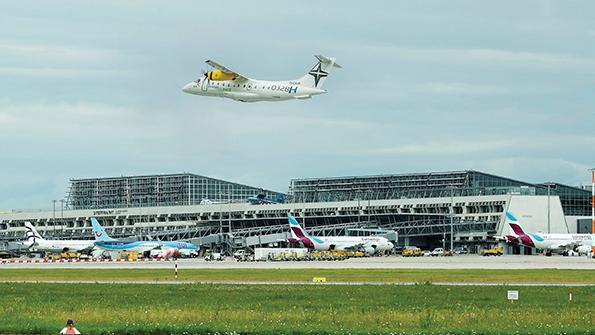

The regional airline sector is becoming a hotbed of propulsion innovation, with airlines and manufacturers embracing the conversion of their turboprops to hydrogen-electric powertrains.
U.S. startup Universal Hydrogen (UH2) has signed letters of intent (LOI) with Icelandair Group, Air Nostrum and Ravn Alaska to retrofit ATR 72 and De Havilland Canada Dash 8 regional turboprops with hydrogen fuel-cell propulsion systems.
- Universal Hydrogen targets ATRs and Dash 8s
- Deutsche Aircraft plans to convert Dornier 328
The LOIs cover replacement of the aircraft’s Pratt & Whitney turboprops with electric motors and fuel cells compatible with UH2’s modular gaseous- and liquid-hydrogen capsules and would also establish the startup as the long-term supplier of green hydrogen to the airlines.
Deutsche Aircraft, which is working to return the Dornier 328 to production, has partnered with German hydrogen-propulsion specialist H2Fly to demonstrate a zero-carbon fuel-cell-powered version of its revamped 320eco regional turboprop.
UH2 is aiming to overcome the hydrogen infrastructure challenge by developing a logistics system based on modular capsules that can be distributed via the global intermodal-container shipping network and loaded into aircraft at the airport before flight.
To kick-start the market for hydrogen, the startup is developing powertrain conversion kits, working with electric-propulsion developer MagniX and Plug Power, a fuel-cell supplier and green hydrogen producer. The team is starting with a 2-megawatt propulsion system to reengine ATRs and Dash 8s.
Starting with the ATR 42/72 and Dash 8-200/300, with the -400 to follow, “the objective is to create conversion kits for all variants,” says Rod Williams, chief commercial officer. “Powertrain and capsule development are applicable across all of them, with relatively minor differences for specific applications. Apart from the -400, which would come as a second step, they are essentially in the same class of power.”
Converted aircraft will have operating economics equivalent to or better than the baseline turboprops, UH2 projects. “At entry into service in 2025, with reductions in the price of green electricity and green hydrogen, increases in the price of Jet A and carbon taxes, and with the lower maintenance cost of the fuel-cell powertrain, the per-seat-mile economics of the hydrogen Dash 8-300 will be equivalent to Jet A,” Williams says.
A subscale powertrain ground demonstrator has been run at lower power to test UH2’s energy management and control system, and full-scale prototypes of two gaseous-hydrogen capsules and a composite module have been produced. In the coming months, the system will go through a series of technology spirals to take the powertrain to the ultimate 2-megawatt level.
The LOI with Icelandair Group covers conversion of the airline’s domestic Dash 8 fleet to hydrogen propulsion. Iceland’s electric grid is powered by renewable energy, and the agreement includes working with Icelandic hydrogen producers, transportation companies and airports.
Under its LOI, Spain’s Air Nostrum would purchase 11 conversion kits for its existing and future fleet. The regional carrier currently operates five ATR 72s on behalf of Iberia. Ravn Alaska has committed to purchasing five conversion kits for its fleet of Dash 8s.
The memorandum of understanding between Deutsche Aircraft and H2FLY covers development of a 1.5-megawatt liquid-hydrogen fuel-cell propulsion system and installation in a 328 demonstrator expected to fly in 2025. The partners are seeking funding from Germany’s LuFo aviation research program.
Founded in 2014 as an outgrowth of a partnership between German aerospace center DLR and the University of Ulm, H2Fly has a flight-tested fuel-cell powertrain using the four-seat HY4, most recently as part of the EU-funded Mahepa project to develop a modular hybrid-electric propulsion architecture.
“A part of the architecture, the power control and distribution module, is based on the Mahepa project,” says Josef Kallo, co-founder and CEO of H2Fly. “There is an additional EU project called Heaven that is liquid-hydrogen-related and three German national projects on which we will base our work.”
The companies plan to work together on integrating the hydrogen-electric power system into the aircraft as well as defining the specific technical and certification requirements for fuel-cell systems under European Union Aviation Safety Agency CS-25 regulations for large commercial aircraft.
Germany is planning other fuel-cell propulsion demonstrations, with DLR working with MTU Aero Engines to fly a 500-kW system in a 19-seat Dornier 228 testbed in 2026. DLR also plans to ground-test a 1.5-megawatt system for 40-60-seat regional aircraft.
U.S./UK startup ZeroAvia is developing a 600-kW gaseous-hydrogen fuel-cell system for 19-passenger aircraft. Market entry is expected in 2024. ZeroAvia is also developing a larger liquid-hydrogen fuel-cell powertrain for 50-seat-plus regional aircraft, aiming for market entry in 2026.

